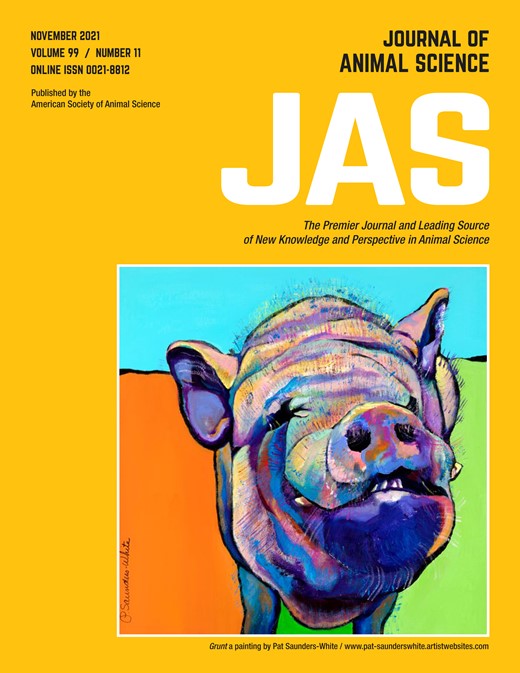-
Views
-
Cite
Cite
Lu Wang, Junyan Zhou, Yifan Chen, Li Wang, Hongmei Pan, Qile Hu, Huangwei Shi, Changhua Lai, Chemical composition, energy content, and amino acid digestibility in Cyperus esculentus co-products fed to growing pigs, Journal of Animal Science, Volume 99, Issue 11, November 2021, skab302, https://doi.org/10.1093/jas/skab302
Close - Share Icon Share
Abstract
This study was conducted to determine the chemical composition, DE, ME, and NE contents, and the apparent and standardized ileal digestibility (AID and SID) of AA in Cyperus esculentus co-products fed to growing pigs. The five C. esculentus co-products included expeller-pressed C. esculentus cake (EPCC), cold-pressed C. esculentus cake (CPCC), solvent-extracted C. esculentus meal (SECM), C. esculentus distillers’s dried grains with solubles (CE DDGS), and C. esculentus meal (CEM). In Exp. 1, a total of 36 crossbred growing pigs (Duroc × Landrace × Yorkshire; BW: 50.12 ± 2.91 kg) were fed one of six diets in a completely randomized design. The diets included a corn-soybean meal basal diet and five experimental diets containing 24.31% C. esculentus co-products. In Exp. 2, 12 same breed of growing pigs (BW: 47.12 ± 3.2 kg), surgically fitted with a T-cannula in the distal ileum, were allotted to one of four experimental diets in a 2-period Youden Square design. The diets included one N-free diet and three experimental diets containing 50% C. esculentus co-products (including EPCC, SECM, and CE DDGS). Results indicated that the SECM and CE DDGS had the greatest contents of starch and CP, respectively. The contents of CF, NDF, and ADF were the greatest in CEM and the lowest in SECM. On a DM basis, the DE, ME, predicted NE, and apparent total tract digestibility (ATTD) of GE values of the 5 C. esculentus co-products ranged from 1,203 to 3,897 kcal/kg, 1,127 to 3,621 kcal/kg, 536 to 2,871 kcal/kg, and 28% to 79%, respectively. The EPCC and CPCC had the greatest DE, ME, and predicted NE values, and CPCC, EPCC, and SECM had the greatest ATTD of GE, whereas CEM had the lowest DE, ME, NE, and ATTD of GE (P < 0.001). The NDF and ADF were negatively correlated with DE, ME, and NE (P < 0.05). The AID and SID of CP varied from 53.57 % to 57.86% and from 69.99% to 87.85%, respectively. The EPCC and SECM had greater SID of CP, Ile, Met, Val, Asp, Cys, and Tyr compared to those of CE DDGS (P < 0.05). These results indicated that the chemical composition, DE, ME, and NE as well as the most AA digestibility of C. esculentus co-products obtained from different processing techniques varied greatly. Based on the energy contents and AA digestibility, the EPCC is a better feedstuff for growing pigs compared with the other 4 C. esculentus co-products.





